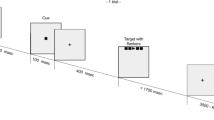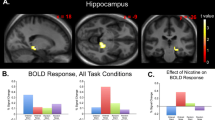Summary
The afferent humoral system exerts significant influences on brain activity. Central nervous actions of the adrenocorticotropic hormone (ACTH) are most likely to be mediated by information coded in a portion of this hormone structure corresponding to ACTH 4–10. Our previous research suggested an impairing effect of ACTH 4–10 on electrophysiological signs of selective attention in humans. The present experiments in 12 male subjects investigated the influences of ACTH 4–10 on different aspects of attention as indicated by auditory event-related potential (AERP) components. Furthermore, doseresponse characteristics of these influences should be examined. Attention performance was tested in a dichotic listening paradigm, after 0, 0.1, 1.0, and 10 mg ACTH 4–10, administered intravenously 1 h prior to testing according to a double-blind latinsquare design. Different aspects of attention were measured by brain electrical responses evoked either by frequent standard or rare target tone pips, which the subject had to attend to, or to ignore. The selective type of attention was reflected by the Nd determined as mean difference in amplitude between AERPs to tone pips when attended and when unattended, for a latency range between 0–460 ms post-stimulus. In addition, plasma cortisol, heart rate, blood pressure, and behavioral performance were measured. Results indicated a clear reduction of the Nd amplitude after all doses of ACTH 4–10. Other indicators of attention mechanisms such as mismatch processing were not affected by the peptide. The diminished Nd after ACTH 4–10 was due to an increased processing of unattended stimuli, but simultaneously attended tones were processed less intensively. The effect of ACTH 4–10 on the Nd increased in strength with increasing doses applied. The demonstration of a linear dose-dependence of actions on the Nd supports a physiological significance for the actions of the neuropeptide ACTH 4–10 on attention.
Similar content being viewed by others
References
Arnsten AFT, Segal DS, Neville HJ, Hillyard SA, Janowsky DS, Judd LL, Bloom FE (1983) Naloxone augments electrophysiological signs of selective attention in man. Nature (Lond) 304: 725–727
Beckwith BE, Sandman CA (1982) Central nervous system and peripheral effects of ACTH, MSH, and related neuropeptides. Peptides 3: 411–420
Born J, Fehm HL, Voigt KH (1986) ACTH and attention in humans: a review. Neuropsychobiology 15: 165–186
Born J, Fehm-Wolfsdorf G, Schiebe M, Birbaumer N, Fehm HL, Voigt KH (1985) An ACTH 4–9 analog impairs selective attention in man. Lif Sci 36: 2117–2125
Born J, Fehm-Wolfsdorf G, Schiebe M, Rockstroh R, Fehm HL, Voigt KH (1984) Dishabituating effects of an ACTH 4–9 analog in a vigilance task. Pharmacol Biochem Behav 21: 513–519
Born J, Fehm-Wolfsdorf G, Voigt KH, Fehm HL (1987) Influences of ACTH 4–10 on event-related potentials reflecting attention in man. Physiol Behav 39: 83–89
DeWied D (1983) Neuropeptides and behaviour. In: Parnham MJ, Bruinvels J (eds) Discoveries in pharmacology, Vol 1. Psycho-and neuro-pharmacology. Elsevier Science Publishers, Amsterdam, pp 307–353
Donchin E (1981) Surprise... Surprise? Psychophysiology 18: 493–513
Donchin E, Heffley E (1978) Multivariate analysis of event-related potential data: a tutorial review. In: Otto D (ed) Multidisciplinary perspectives in event-related brain potential research. U.S. Government Printing Office, Washington D.C., pp 553–572
Endröczi E, Lissak K, Fekete M, DeWied D (1970) Effects of ACTH on EEG habituation in human subjects. Progr Brain Res 32: 254–261
Fekete M, DeWied D (1982) Naltrexone-insensitive facilitation and naltrexone-sensitive inhibition of passive avoidance behavior of the ACTH-(4–9) analog (ORG 2766) are located in two different parts of the molecule. Eur J Pharmacol 81: 441–448
Fehm-Wolfsdorf G, Elbert T, Lutzenberger W, Rockstroh B, Birbaumer N, Fehm HL (1981) Effects of ACTH 4–9 analog on human cortical evoked potentials in a two-stimulus reaction time paradigm. Psychoneuroendocrinology 6: 211–230
Gaillard AWK (1981) ACTH analogs and human performance. In: Martinez J, Jensen R, Messing RB, Rigter H, McGaugh JL (eds) Endogenous peptides and learning and memory processes. Academic Press, New York, pp 181–196
Hillyard SA, Hink RF, Schwent VL, Picton TW (1973). Electrical signs of selective attention in the human brain. Science 182: 177–180
Hillyard SA (1985) atElectrophysiology of human selective attention. TINS: 400–405
Lichtensteiger W, Lienhart R, Kopp HG (1977) Peptide hormones and central dopamine neuron systems. Psychoneuroendocrinology 2: 237–248
Meisenberg G, Simmons WH (1983) Peptides and the blood-brain barrier. Life Sci 32: 2611–2623
Miller LH, Harris LC, Van Riezen H, Kastin AJ (1976) Neuroheptapeptide influence on attention and memory in man. Pharmacol Biochem Behav 5, Suppl. 1: 17–21
Mizuki Y, Tanaka M, Isozaki H, Nishijima H, Inanaga K (1980) Periodic appearance of theta rhythm in the frontal midline area during performance of a mental task. Electroencephalogr Clin Neurophysiol 49: 345–351
Murphy BP, Engelberg W, Pattee CJ (1967) Some studies of the protein-binding of steroids and their application to the routine micro and ultramicro measurements of various steroids in body fluids by competitive proteinbinding radioassay. J Clin Endocrinol Metab 27: 973–990
Näätänen R (1985) Selective attention and stimulus processing: reflections in evoked potentials, magnetencephalogram, and regional cerebral blood flow. In: Posner MI, Marin OS (eds) Attention and performance, Vol XI Erlbaum, Hillsdale NJ, pp 355–373
Näätänen R (1982) Processing negativity: an evoked-potential reflection of selective attention. Psychol Bull 92: 605–640
Näätänen R, Michie PT (1979) Early selective attention effects on the evoked potential: a critical review and reinterpretation. Biol Psychol 14: 81–136
Näätänen R, Simpson M, Loveless NE (1982) Stimulus deviance vs. significance and event-related brain potentials. Biol Psychol 14: 53–98
Parasuraman R (1978) Auditory evoked potentials and divided attention. Psychophysiology 15: 460–465
Pigache R (1982) A peptide for the aged? Basic and clinical studies. In: Wheathley D (ed) Psychopharmacology of old age. Oxford University Press, Oxford, pp 67–96
Rockstroh B, Elbert T, Lutzenberger W, Birbaumer N, Fehm HL, Voigt KH (1981) Effect of an ACTH 4–9 analog on human cortical evoked potentials in a constant foreperiod reaction time paradigm. Psychoneuroendocrinology 6: 301–310
Rockstroh B, Elbert T, Lutzenberger W, Birbaumer N, Voigt KH, Fehm HL (1983) Distractibility under the influence of an ACTH 4–9 derivate. Int J Neurosci 22: 21–36
Sandman CA, Walker BB, Lawton CA (1980) An analog of MSH/ ACTH 4–9 enhances interpersonal and environmental awareness in mentally retarded adults. Peptides 1: 109–114
Sandman CA, Berka C, Walker BB, Veith J (1985) ACTH 4–9 effects on the human visual event-related potential. Peptides 6: 803–807
Sandman CA, Kastin AJ (1977) Pituitary peptide influences on attention and memory. In: Drucker-Colin RR, McGaugh JL (eds) Neurobiology of sleep and memory. Academic Press, London, pp 347–360
Sternberg S (1966) High-speed scanning in human memory. Science 153: 652–654
Van Nispen JW, Greven HM (1982) Structure-activity relationships of peptides derived from ACTH, β-LPH and MSH with regard to avoidance behavior in rats. Pharmacol Ther 16: 67–102
Watson SJ, Akil H, Richard III CW, Barchas JD (1978) Evidence for two separate opiate peptide neuronal systems. Nature (Lond) 275: 226–228
Author information
Authors and Affiliations
Rights and permissions
About this article
Cite this article
Born, J., Bräuninger, W., Fehm-Wolfsdorf, G. et al. Dose-dependent influences on electrophysiological signs of attention in humans after neuropeptide ACTH 4–10. Exp Brain Res 67, 85–92 (1987). https://doi.org/10.1007/BF00269456
Received:
Accepted:
Issue Date:
DOI: https://doi.org/10.1007/BF00269456




